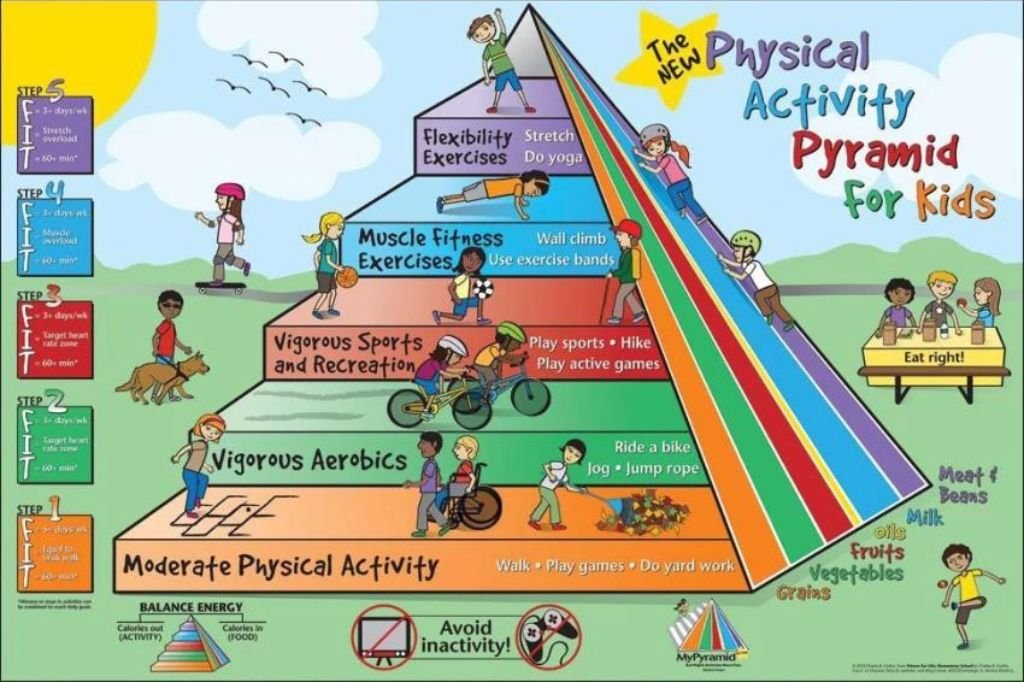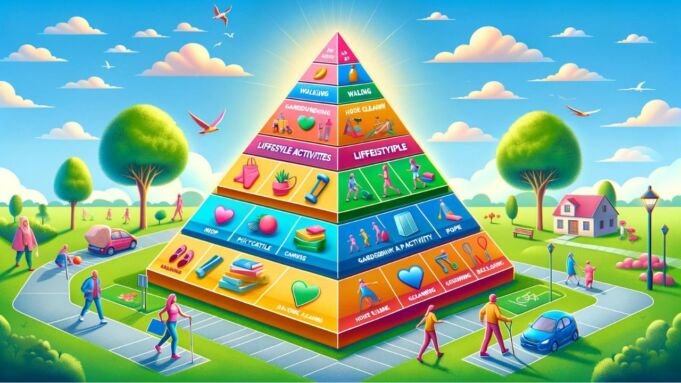Where on the Physical Activity Pyramid do Lifestyle Activities Belong? The concept of a Physical Activity Pyramid is a powerful tool in the world of fitness and health, offering a visual representation of the different types of physical activities and their recommended frequency. This pyramid serves as a guide, much like the well-known food pyramid, to help individuals understand and organize their exercise routines for optimal health benefits. Understanding where different activities fall within this pyramid is crucial for creating a balanced and effective fitness regimen that caters to all aspects of physical health.
What is the Physical Activity Pyramid?
The Physical Activity Pyramid serves as an illustrative guide that assists individuals in identifying various daily and sports activities that contribute to a healthy lifestyle. It helps in understanding which activities should be done frequently, like daily, and which can be done less often, like weekly.
Developed by the Park Nicollet Medical Foundation, an American organization advocating for healthier living, this pyramid takes inspiration from the concept of the Food Pyramid.
This pyramid effectively demonstrates, through a visual representation, how to mix different types of physical activities to foster an active and healthy way of life. Its primary goal is to offer a roadmap for progressively incorporating physical exercises into everyday routines. Below, the Physical Activity Pyramid is presented to aid you in effectively organizing your physical activities.
Importance of lifestyle activities
Living a healthy lifestyle encompasses engaging in regular physical activities, consuming a well-balanced diet, and getting adequate sleep. These elements are vital for sustaining good health and warding off diseases.
Engaging in physical activities is key to overall health and wellness. It plays a significant role in warding off conditions like obesity, cardiovascular diseases, strokes, cancer, and other chronic ailments. Consistent exercise also enhances mood and energy levels and positively impacts mental health.
Consuming a nutritious diet is crucial for supplying the body with the necessary nutrients for maintaining optimal health. Eating a diverse range of wholesome foods ensures the body gets all the essential vitamins and minerals it needs. It’s equally important to moderate the intake of unhealthy foods and beverages, including saturated and trans fats, sugars, and alcohol.
Adequate sleep is fundamental to overall health and wellness. Insufficient sleep can result in tiredness, mood fluctuations, and a compromised immune system. Furthermore, sleep plays a critical role in cognitive functions and memory retention.
Read More: The Mama Maven Blog NYC Mom Lifestyle Blog
Physical Activity Pyramid Levels
First Level
The base level of the pyramid incorporates everyday activities. These are actions that form part of your daily routine, such as walking to school or opting for the stairs over an elevator. Engaging in active play and sports is crucial as it benefits heart and lung health, strengthens bones and muscles, aids in maintaining a healthy weight, and reduces the risk of chronic illnesses.
Second Level
The second tier consists of moderately intense activities. These are exercises that increase your breathing and heart rate, yet still allow you to speak in complete sentences. Examples include cycling, swimming, and dancing. Such activities are excellent for cardiovascular health and building endurance.
Third Level
The third tier involves highly vigorous activities that cause significant increases in breathing and heart rate. During these intense exercises, like running, jumping rope, and playing basketball, you may only manage short sentences. These activities are great for calorie burning, muscle strengthening, and enhancing power.
Fourth Level
This level focuses on strength-building exercises. Activities that fall here contribute to stronger muscles and bones. Examples include lifting heavy objects, doing push-ups and sit-ups, and using resistance bands.
Fifth Level
The fifth level is dedicated to improving flexibility. Activities like yoga, tai chi, and stretching fall into this category, aiding in making muscles and joints more pliable.
Sixth Level
The top of the pyramid represents activities that should be limited or avoided, such as prolonged sitting and excessive TV watching. These are activities that contribute least to physical fitness and health.
Activity Recommendations for Adults

For adults, the key is to be more active and reduce sedentary time throughout the day. Any physical activity is better than none at all.
To gain substantial health benefits, adults should aim for:
- A minimum of 150 to 300 minutes of moderate-intensity physical activity per week.
- At least 75 to 150 minutes of vigorous-intensity aerobic activities weekly.
- Alternatively, a mix of moderate and vigorous-intensity aerobic activities spread throughout the week.
- Muscle-strengthening activities, of at least moderate intensity, should be done twice a week or more, focusing on all the major muscle groups.
- Activities that do not raise your heart rate do not contribute to the recommended daily 30 minutes of physical activity.
Examples of activities that typically don’t increase heart rate include slow-paced walking, grocery shopping, and light household chores.
Read Also: Hot Beauty Health A Beauty Fashion Lifestyle Blog
Where Do Sedentary Activities Belong On The Pyramid?
Activities that involve prolonged sitting and watching TV are excluded from the physical activity pyramid due to their lack of contribution to health and fitness. These sedentary behaviors don’t offer any physical exercise benefits and can, in fact, harm health. Extended periods of sitting are linked to a heightened risk of obesity, heart disease, and various other health issues.
As a result, it’s advisable to minimize sedentary activities as much as possible. People should aim to boost their physical activity by engaging in the exercises and movements outlined in the physical activity pyramid.
Physical Activities for Children
Regular physical activity is highly beneficial for children and teenagers, enhancing their health and fitness levels.
Motivating children to participate in at least an hour of enjoyable moderate to vigorous physical activities daily is essential. Here are some ideas to foster an active and healthy lifestyle for them:
- Engaging in dance
- High-energy play, like tag or jumping rope
- Biking or BMX riding
- Swimming
- Roller skating, using rollerblades, or skateboarding
- Involvement in after-school sports or physical activity programs
Physical Activity Pyramid Guidelines for Children
The initial step in integrating the physical activity pyramid into children’s lives is to limit inactive periods to less than two hours during the day. This pertains to watching TV, playing computer games, or other sedentary activities. The focus is not on completely avoiding these activities but on moderating the time spent on them.
Global expert recommendations state that children and adolescents should engage in at least 60 minutes of moderate to vigorous physical activity daily. Additionally, activities that enhance bone health, muscle strength, and flexibility should be included at least twice a week.
Also Read: Ape to Gentleman Men’s Grooming Fashion Lifestyle
Physical Activity Pyramid Levels for Children Explained

Understanding the pyramid’s significance, it’s helpful to recognize its structure. The pyramid is divided into four levels, each representing activities with varying frequencies: daily, frequent, several times a week, and occasionally.
Level 1 – Foundation
The base of the pyramid advises avoiding inactivity for more than two hours daily. Recommended daily activities include walking to school, assisting with shopping, using stairs, or walking the dog.
Level 2 – Flexibility and Muscular Fitness
This level focuses on flexibility activities like stretching, gymnastics, yoga, Pilates, and muscular fitness activities such as rope climbing and exercises with elastic bands. These should be done two or three days a week, requiring more muscle use than usual. The emphasis is on sports that improve coordination, strength, endurance, and dexterity, ideally once or twice a week.
Level 3 – Aerobic Activities
Level three involves aerobic activities like running, jumping, cycling, swimming, or skating. These should be conducted three to six days a week for at least 30 minutes, ensuring an elevated heart rate during the activity. These outdoor activities enhance overall well-being.
Level 4 – Daily Physical Activities
Children should engage in daily activities, such as walking to and from school, participating in school recess or activity clubs, playing games in the afternoons, and weekend activities like long walks or bike rides. These activities, done every or almost every day for at least 60 minutes at moderate intensity, can include light running, gentle swimming, and sports like football and basketball.
Benefits of Physical Activity for Children
Implementing the physical activity pyramid and encouraging physical activity in children comes with numerous notable benefits:
- It helps maintain a healthy weight, preventing issues related to overweight.
- Significantly enhances the child’s skeletal and muscular system.
- Improves key physical attributes like coordination, strength, flexibility, and balance.
- Provides an outlet for children with high energy levels to channel and regulate that energy.
- Lowers the risk of the child developing cardiovascular or degenerative diseases.
- Instills a healthy habit that will be beneficial throughout their entire life.
Challenges and Misconceptions
Common Misconceptions: There’s a prevalent misconception that lifestyle activities are not “real exercise” or are less effective than structured workouts. However, research shows that consistent, moderate-intensity activities integrated into daily life can significantly impact health and fitness levels.
Addressing Barriers: Common barriers include a lack of time, motivation, or understanding of the benefits. Overcoming these involves recognizing the value of small, consistent activities and finding ways to incorporate them into the daily routine.
The Importance of Consistency and Variety: Maintaining a consistent routine of lifestyle activities is crucial for long-term health benefits. Adding variety, such as trying different walking routes or engaging in various household tasks, can keep the routine interesting and effective. This diversity not only enhances physical fitness but also ensures mental engagement and motivation.
Also Read: My Little Babog Family Lifestyle Travel Blog
Conclusion
Where on the Physical Activity Pyramid do Lifestyle Activities Belong? Lifestyle activities are a crucial component of the Physical Activity Pyramid, forming the bedrock of our daily movement patterns and playing a key role in maintaining overall health and wellness. Integrating these activities into our daily routines promotes a more active and balanced way of living, aiding in the achievement of our health and fitness objectives. Acknowledging the value of lifestyle activities and implementing minor adjustments to enhance our daily movement can lay a strong groundwork for a healthier and more active life ahead.
Frequently Asked Questions (FAQs)
Let’s have a look at some commonly asked questions about ‘Where on the Physical Activity Pyramid do Lifestyle Activities Belong.’
Can lifestyle activities help with weight loss?
Lifestyle activities do assist in managing weight, but for more effective weight loss, it’s essential to pair them with a balanced diet and regular structured exercise routines.
Is walking considered a sufficient lifestyle activity?
Indeed, walking is a highly beneficial and easily accessible lifestyle activity that offers a range of health advantages, notably enhancing cardiovascular health.
What are lifestyle activities in the context of the Physical Activity Pyramid?
Lifestyle activities refer to everyday physical actions that are part of our routine but not necessarily structured exercise, such as walking to work, gardening, or taking the stairs instead of the elevator. In the Physical Activity Pyramid, these activities form the base layer, indicating their fundamental role in daily physical activity.
Why are lifestyle activities important in the Physical Activity Pyramid?
Lifestyle activities are important because they contribute significantly to our overall physical activity levels. They are easy to incorporate into daily life and provide health benefits such as improved cardiovascular health, better weight management, and reduced risk of chronic diseases.
How often should I engage in lifestyle activities according to the pyramid?
Lifestyle activities should ideally be a part of your daily routine. The Physical Activity Pyramid emphasizes regular engagement in these activities due to their cumulative health benefits over time.
Can lifestyle activities replace more structured forms of exercise?
While lifestyle activities are crucial, they should complement, not replace, more structured forms of exercise like aerobic workouts, strength training, and flexibility exercises. A balanced approach that includes both lifestyle















